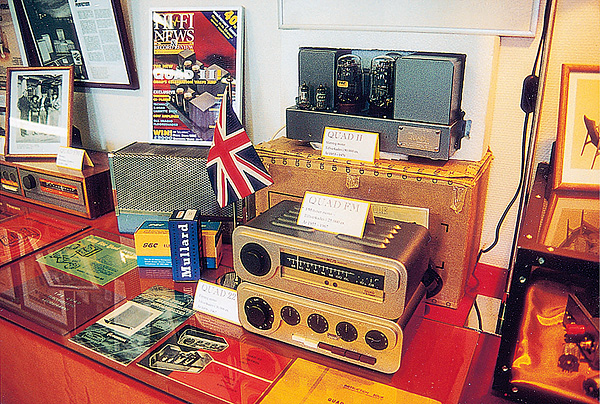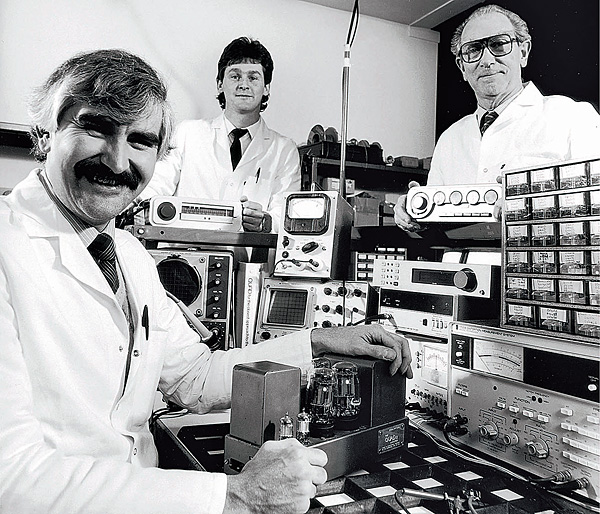Quad to the Core Page 2

Dodgy Plugs
Another quirky aspect of Quad production Ken recalls involved the Quad 33. 'We were producing it with these horrible DIN plugs. Now there were a lot of things written about DIN plugs at the time, singing their praises, and Peter Walker, in his wisdom, wanted to get away from phono plugs because they'd readily fall out in use.
'The original RCA plug was tapered, so after you plugged it in once, the second time it would often fall out, where the later phonos didn't. So that was a joke on us because we didn't build it with phonos – we used DINs. DINs have their advantages, but the main disadvantage was there was no “fiddle factor” for the customer, and hi-fi always needs a fiddle factor.
'And then, of course, the 34 comes along and we built it with DINs, and suddenly, because of the American market, we had to change back to phono sockets. So we made a huge load of them before we went back to phono. With a DIN, you had a single connector with five pins, for your left and right, whereas phonos take a lot of area on the back panel. DIN was the SCART of its day, really.'

Yet another memorable controversy concerned the evolution of the Quad 405 to the 405-2. 'We were having difficulty with some loudspeakers. The 405 had a passive current limiter. What actually happened was, as the impedance of the speaker fell, the current limiter would come in, and it would then make funny, farty noises through the speaker. PJ [Peter Walker] and KEF were very pally at the time so we tested with KEF 104ABs – the acoustic Butterworths – but there was also this new company [Mission] that came along with the 770.'
Burn Out
Hugely popular, the 770s – like the KEFs – were likely candidates for 405 owners who didn't have Quad ESLs. Moreover, they were adored by certain reviewers who raved about them uncontrollably. 'They [Mission] were having problems with some of their drive units because they bought them from odd places. They seemed to burn out on 405s for some unknown reason, and they were blaming the 405.
'We had some of their speakers, and we thrashed them and thrashed them and thrashed them, and we couldn't get them to die. We couldn't ever sort it out. I personally wouldn't condemn the 770 – it had an impedance that was all over the place – and we don't know what people had done to it. But there was this farty business – I can only describe it as that – on transients when the impedance dropped.

'We had a guy who worked for us called Max Hadley. He was brilliant. So he comes along and he – what he called “turbo'd” it, and what he did was to build a little thick film circuit that held off the current. So, for so many milliseconds, it could pass 'infinite' current, but then this little circuit fires in and protects the speaker if somebody's done something daft. And that's where the 405-2 came in. Suddenly, you could get 100W into 4ohm, where before we were struggling to achieve 80W.'
Quad produced 64,000 405s between 1975 and 1982, and clearly the fix worked well: it would go on to sell 100,000 405-2s before the amp went out of production in 1993. Ken maintains that, side-by-side, there was no sonic difference between them. 'If you were to drive them into Quad ESL63s, you couldn't tell them apart because you were not getting near the current limit of the amp – you just couldn't get there.
'You see, originally, the 405 was conceived to go into the bottom of the speaker [the ESL63] to make it an active speaker. In those days, because of the cost of doing that, it fell foul of Quad's pricing structures. So we made the 405 as a separate entity, so it could drive other speakers besides the ESL63 – but it all hinged around the '63. It's easier to do: you put all the transformers onboard, without the capacitors.'
Price Of Power
Why the active ESL63 with onboard 405 never saw production was down to Peter Walker's abhorrence of the astronomical pricing of much 'high-end' gear. He was especially critical of the price tags on high-end hardware from America, and even fell out with Alastair Robertson-Aikman of SME when AR-A stopped using Quad amps because he wanted more power. 'We were making speakers selling for somewhere around £1200 per pair. [Adding 405s] would theoretically stick another £600 or £700 on top of that, fining your customers. So Peter said, “Alright then, we'll cut that bit out” and those customers who can't afford ESL63s will have cone speakers. And that's what they did. A large percentage of 405s went on to partner conventional speakers, not electrostatics.'

Ken's affection for the company is palpable, and one suspects he'll be around to pick up the phone if they need his advice for some intractable problem. He explained the company's reputation for looking after its customers was down to speed and cost. 'We also kept the cost very low because one or two per cent of the sales prices were put aside for service. That's the reason why Quad's service was always so cheap, and we could turn things around in less than a week.

'We had an engineer for each base, but of course you were only looking after, in those days, the few main amps, a small range of FM tuners, and the 33 and 22. There was an engineer on each bench doing that. But the important thing was to get the product through as quick as you could, however nice it was to talk to the customers. If you want to try and guarantee a three-to-five day turnaround, you can't spend a lot of time chatting.'

Full Circle
Any temptation to carry on is countered by Ken having plenty of things to occupy him during his retirement. Still, I did wonder why he chose to sign off with only two years to go before hitting a nice, round 50, and he admitted, 'I didn't really consider that at all. I got to 70, and the family wanted more of my time... I'd done the 48 years.'
Ken's final servicing task brought his near-half-century full-circle, reminding me of what he said back in 2003: 'I think I'm more of an amplifier man than anything else – amps are my forté. But for interest's sake? Tuners are my thing because of my background. I just feel at home with tuners.' But on his final day at the bench, the last unit he worked on was a Quad 33 preamp... one of the models in production when he joined the company.

























































